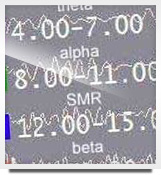Setup and Connections
Connect a special EEG amplifier and sensors to a computer.
 Then put the electrodes on the head. The EEG amplifier reads the EEG from the electrodes that are put on the scalp .
Then put the electrodes on the head. The EEG amplifier reads the EEG from the electrodes that are put on the scalp .
The electrodes detect the client’s brainwave activity. The amplifier picks up this information and converts it into a signal the computer can understand. Every brain produces this tiny electrical (or electro-chemical) activity. It’s in millionths of a volt, or microvolts. Anywhere you place an electrode on the head, EEG activity exists.
 The electrodes are placed on the head where it reads the brainwave activity and sends that information to the computer.
The electrodes are placed on the head where it reads the brainwave activity and sends that information to the computer.
The patient’s brain controls the process. The computer acts as a high-tech mirror, giving instant feedback about the brain.
The computer needs special software that works with the EEG amplifier.
The software takes the brain’s electrical signals and converts it into data the computer can interpret. The special software takes data from the amplifier and converts it into a display. The display can show many bars (spectral activity), graphs, and games.
Programs are designed to provide visual or auditory feedback. For example, the program may beep when the client is making more or less EEG amplitude in the targeted frequency bands. You won’t get beeps when there is too much or too little of specific brain activity.
The path is:
Electrodes » Connected to the head and to the EEG amplifier» Connected to computer » Running software to interpret the signals
 What is the EEG or brainwaves? What does it represent? In simple terms, it’s a physiological measure that represents changes in EEG activity. Frequencies represent our state: sleepy, alert, or agitated.
What is the EEG or brainwaves? What does it represent? In simple terms, it’s a physiological measure that represents changes in EEG activity. Frequencies represent our state: sleepy, alert, or agitated.
We’ll show you in more detail the therapist screen and the game screen.

